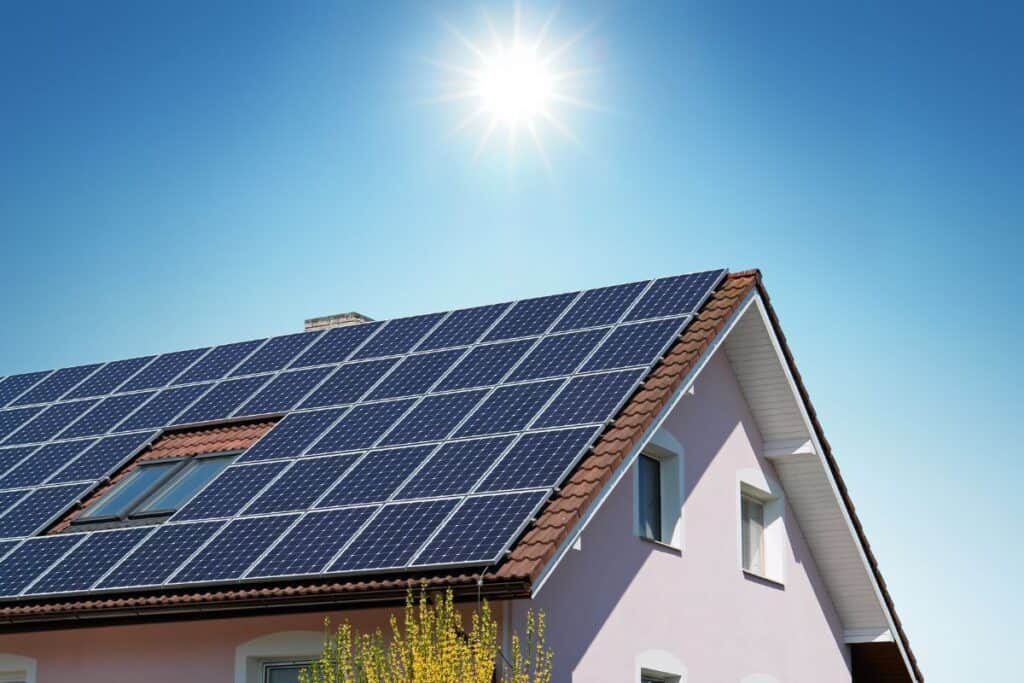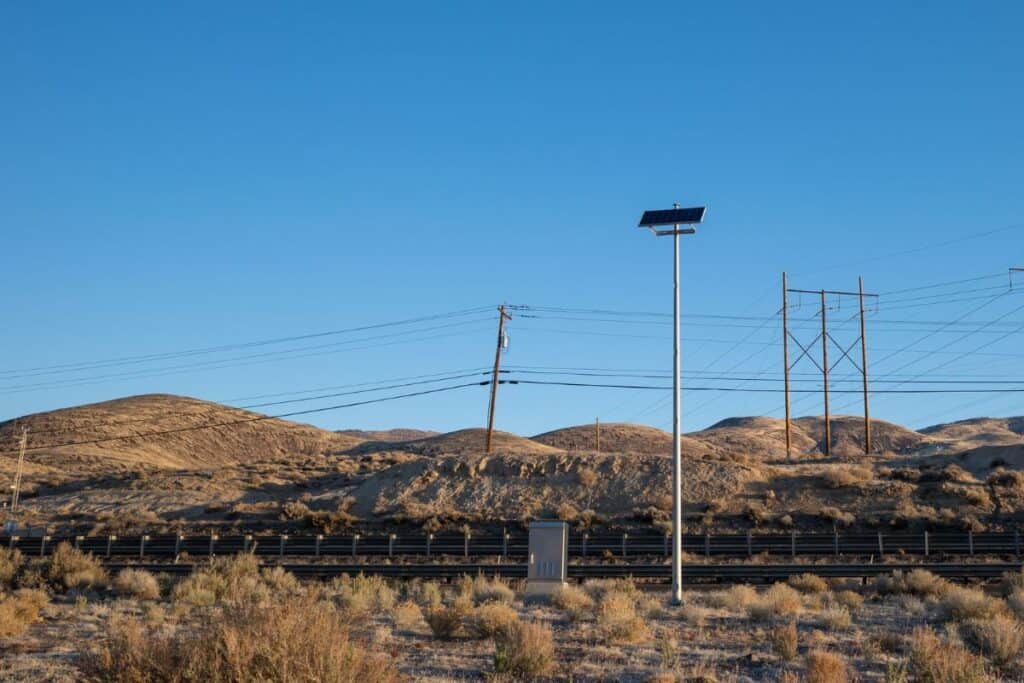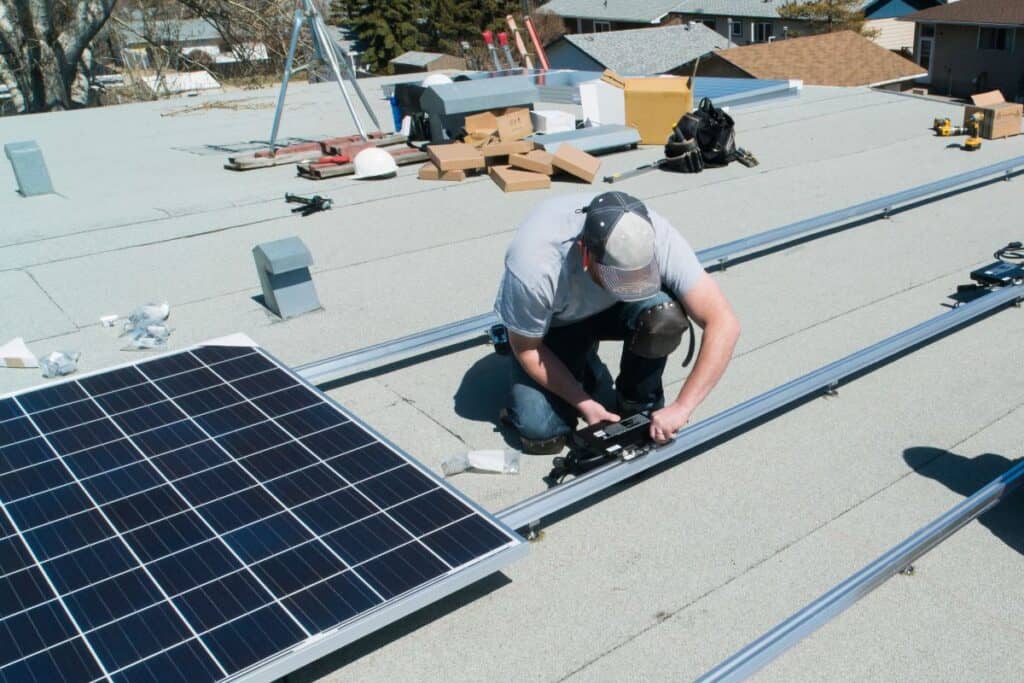So, you’ve decided to join the green energy revolution and you’re thinking about installing solar in Nevada? Brilliant choice!
You’re on your way to sustainable living, but first, let’s explore what you need to know about this transformative journey.
Nevada, with its abundant sunlight, is one of the best places in the US to go solar. However, before you start, there are a few key things to be aware of – from understanding the policies, costs involved, and incentives available to the local regulations that govern solar installations.

Grasping Nevada’s Solar Policies
Nevada, the ‘Sunshine State’, stands as a beacon for solar energy. It’s crucial to understand the state’s policies governing solar installation, primarily the net metering policy.
What is net metering you ask?
Net metering is a billing arrangement that allows solar owners to sell their excess energy back to the grid, offsetting their electric consumption and reducing their energy bills.
(Editor’s note: If you’d like to learn everything there is to know about it, you can read our extensive guide to net metering)
In 2017, Nevada reinstated its net metering policy with Assembly Bill 405, securing the future of solar in the state.
This new policy guarantees residential solar customers will receive 95% of the retail rate for excess electricity sent back to the grid, encouraging more Nevadans to switch to solar.
When you fully understand Nevada’a net metering policy it can lead to substantial savings over time, making your solar investment more profitable.
How Much Money Can You Save Using Solar In Nevada?
Let’s break it down with an example to show how beneficial this can be.
Consider this scenario: you have a 5kW solar system installed at your home. On a sunny day, let’s say your system generates 30 kWh of energy, but you only use 20 kWh. The extra 10 kWh is sent back to the grid. With net metering, you’re given a credit for this excess 10 kWh at 95% of the retail rate. So, if the retail rate is 12 cents per kWh, you’d get a credit of about $1.14 (10 kWh * 12 cents/kWh * 95%) on your electricity bill for that day.
This way, net metering allows you to balance out your electricity production and consumption, effectively saving you money on your energy bills.
Additionally, Nevada’s net metering policy doesn’t limit the size of your system based on your current electricity usage, allowing you to maximize your system size and potential savings.
Nevada’s commitment to net metering makes solar energy a highly attractive proposition for homeowners, leading to greater energy independence and a reduced carbon footprint.
It’s another excellent reason to consider making the switch to solar in the Silver State.
That’s all good and well once you have your solar panels installed, what about the upfront cost?
The Cost of Installing Solar in Nevada: A Practical Financial Example
If you’re wondering how much it costs to install solar in Nevada, you’re not alone. Let’s delve into the costs and provide you with a practical financial example.
On average, it costs between $15,000 to $25,000 before incentives and rebates to install solar in Nevada. This does depend on the size of the system and the specific needs of your home.
Let’s now dig a bit deeper into the numbers to get a better understanding.
Suppose you install a 5 kilowatt (kW) system, which is the typical size for a residential home. At an average cost of $3 per watt in Nevada, the gross cost of your system would be $15,000.
However, the actual cost is significantly lower once you factor in the incentives available.
Firstly, there’s the federal Solar Investment Tax Credit (ITC), which offers a 26% tax credit on the cost of your system. For a $15,000 system, that’s a savings of $3,900, bringing the cost down to $11,100. We’ll discuss this in a bit more detail shortly.
Additionally, as discussed above, Nevada offers net metering, which credits you for the excess electricity your system feeds back into the grid.
Assuming you are able to offset your electricity consumption by 75% with your solar panels, and that your average monthly electricity bill is $150, this means you’d save about $1,350 in the first year alone!

Solar panels in Nevada increase your property value
It is also important to remember that solar panels often increase property values.
According to studies, homes with solar panels sell for about 4% more on average than similar homes without solar. For a home valued at $300,000, that’s an extra $12,000 in your pocket if you decide to sell.
So, while the upfront cost might seem steep, the financial benefits of solar installation in Nevada are substantial.
You’ll not only significantly reduce your electricity bills, but you’ll also increase your home’s value and help preserve the environment – a win-win situation, indeed.
Let’s circle back to Nevada’s Federal Solar Investment Tax Credit.
Understanding the Federal Solar Investment Tax Credit in Nevada: A Practical Example
So what’s the deal with this Federal Solar Investment Tax Credit, and how does it benefit me as a Nevada homeowner you ask? Let’s break it down and provide a tangible financial example.
The Federal Solar Investment Tax Credit (ITC) is a major incentive for homeowners looking to go solar, as it allows you to deduct 26% of the cost of installing a solar energy system from your federal taxes.
Sounds good, right? But how does this look in real numbers?
Let’s assume you install a solar system that costs $20,000. With the 26% Federal Solar ITC, you could deduct $5,200 ($20,000 x 26%) off your federal income taxes. This is a substantial saving, reducing the total cost of your solar system to $14,800.
Here’s where it gets even better: there’s no cap on its value, and you can roll over any remaining credits to the next tax year if you owe less tax than the value of your credit.
That means if you owed $4,000 in taxes for the current year, you would pay nothing and still have $1,200 in credit to deduct from your taxes the following year.
Just remember that the ITC steps down in 2023 to 22%, and is set to expire in 2024 unless Congress renews it.
So, if you’re considering solar, it may be financially beneficial to act sooner rather than later to maximize your savings.
Another tax incentive that the Sunshine State offers to homeowners who install solar is Nevada’s Property Tax Exemption for solar.

Understanding Nevada’s Property Tax Exemption for Solar
This tax exemption is a significant benefit for homeowners planning to install solar panels. This is how it works.
Nevada offers a property tax exemption for homeowners who install solar power systems. This policy is hugely beneficial. It allows you to increase the value of your property without having to pay more in property taxes.
When you install a solar energy system, it increases the value of your home. Without the exemption, the added value would increase your property taxes.
However, in Nevada, the added value from a solar system is exempt from property tax assessment, meaning your property taxes won’t go up.
Let’s dive deeper to explain this with an example. Suppose you own a house in Nevada valued at $250,000. You decide to install a solar energy system costing $20,000, which increases the value of your house to $270,000.
Usually, this increased value would lead to higher property taxes. But thanks to Nevada’s property tax exemption, the added $20,000 in value from your solar system is not counted towards your property tax.
This law makes solar power systems more affordable for Nevada homeowners. It encourages more homeowners to install solar power systems, which is beneficial for the environment and the state’s renewable energy goals.
If you’re considering going solar, it’s essential to understand these financial incentives and benefits to get the most from your solar energy system.
Remember, every homeowner’s situation is unique. It’s always a good idea to consult with a tax professional or solar advisor to fully understand the implications of these benefits for your specific circumstances.
Now that we’ve got through the good stuff, let’s look at what other laws or acts come into play when installing solar in Nevada.
Navigating Nevada’s Solar Laws: Be in the Know
Now you might be wondering, aside from net metering, are there any other laws in Nevada relating to solar you should be aware of?
Yes, indeed, there are! Understanding these laws will help you maximize the benefits of your solar installation.
Nevada’s legislature has enacted a series of laws that support solar energy adoption. One of these is the “Renewable Portfolio Standard” (RPS). The RPS is a mandate that requires utilities in Nevada to procure a percentage of their power from renewable resources.
Nevada’s RPS goal is to reach 50% renewable energy by 2030.
As a part of these renewable resources, solar energy has a significant role, which indirectly encourages more residential and commercial solar installations.
Moreover, Nevada enacted the “Solar Access Law” which prevents homeowners associations (HOAs) from prohibiting solar installations.
This law is a big win for homeowners interested in going solar but living under HOA regulations.
The Solar Access Law in Nevada: Benefits and Practical Examples
The Solar Access Law in Nevada is a key regulation that ensures homeowners have the right to install solar panels on their property. It provides many advantages, some of which can be experienced directly.
Firstly, this law prohibits any entity, such as homeowner associations (HOAs), from preventing you from installing solar panels.
For example, suppose you live in a community governed by an HOA that has regulations about changes to home exteriors.
In the past, some of these associations have tried to stop homeowners from installing solar panels due to aesthetic concerns. However, under the Solar Access Law, they cannot prevent you from going solar.
Secondly, the Solar Access Law can help protect your solar investment from potential shading caused by future construction.
Imagine you’ve installed a rooftop solar system. A few years down the line, your neighbor decides to build a second story that would shade your panels and decrease their output.
Under the Solar Access Law, your solar rights are protected. Your neighbor would be required to consider this in their construction plans.
Additionally, the Solar Access Law also preserves your right to sell the excess electricity your solar panels generate back to the grid. This is usually in the form of net metering credits.
This means if your solar panels produce more electricity than you use in a day, that excess electricity will go back into the grid, and you will receive a credit on your electricity bill. (This is how net metering works)
Energy storage in conjunction with solar power policy in Nevada
Nevada also has policies in place to encourage energy storage in conjunction with solar power. Assembly Bill 405, the same law that reinstated net metering, also includes a “ratepayer bill of rights” which provides strong consumer protections for residential customers with energy storage systems.
This includes rights regarding system performance, durability, and safety.
It’s important to note that while these state-wide laws and policies provide an overall supportive environment for solar, local permitting and zoning laws can vary.
Local Permitting and Zoning Laws in Nevada: How They Benefit Solar Installation
Let’s dive into some of Nevada’s local permitting and zoning laws.
In Nevada, local permitting and zoning laws play a crucial role in the solar installation process. This facilitates smoother and more efficient transitions to renewable energy.
To begin with, permitting processes for solar panels in Nevada have been streamlined to ensure a more efficient approval timeline.

For instance, Clark County, which includes Las Vegas, has an expedited permitting process for small residential rooftop solar systems. This means less waiting time for you to start reaping the benefits of your solar panels.
Additionally, Nevada’s local zoning laws are also friendly to solar energy.
These laws typically allow for “accessory uses,” which means homeowners can install solar panels as a secondary use to their property without requiring any special permission or going through any exhaustive process.
For example, if your house is in a residential zone, the zoning laws will not stop you from installing solar panels on your rooftop or in your yard, as these are considered accessory uses.
Some areas in Nevada also have specific regulations that prevent homeowners associations from restricting solar panel installations.
In Reno, for example, homeowners associations cannot prohibit you from installing solar panels on aesthetic grounds.
This means you won’t have to worry about arbitrary rules preventing you from harnessing solar energy on your property.
Lastly, Nevada also has laws that allow for solar easements.
This means you can enter into a voluntary agreement with your neighbor that ensures your solar panels will always have access to sunlight, regardless of any future structures they may want to build.
Now that most of the red tape is out of the way, it’s time to look at how to connect to the grid in Nevada

Connecting Your Solar Panels to the Grid in Nevada: A Step-by-Step Guide
Connecting your solar panels to the power grid in Nevada involves a few essential steps. It may seem daunting at first, but don’t worry, we’re here to make it simple for you.
Firstly, you’ll need to apply for an interconnection agreement with your local utility company. This agreement allows your solar system to safely connect and interact with the power grid.
It’s crucial for ensuring the safety of both the solar system owner and the utility workers.
How To Obtain An Interconnection Agreement in Nevada
Firstly, it’s crucial to understand that you should never connect your solar system to the power grid without an official interconnection agreement.
Doing so can have legal repercussions and might even result in the disconnection of your electricity service.
To obtain an interconnection agreement in Nevada, here’s a step-by-step guide to follow:
- Contact Your Utility Company
Reach out to your local utility company to request an interconnection agreement application. Nevada has a few different utility companies, including NV Energy, Valley Electric Association, and Lincoln County Power District, so be sure to contact the right one for your area.
- Submit the Application
Once you have the application, fill it out carefully. You may need to provide information about your solar system, including its size, location, and installation date. It’s often recommended to work with your solar installer during this step to ensure the information is accurate.
- System Inspection
After submitting your application, your utility company will inspect your solar system to ensure it meets its safety and performance standards.
- Approval and Agreement
If your system passes inspection, the utility company will approve your application and provide an interconnection agreement. This agreement outlines your responsibilities as a solar system owner and the utility’s obligations.
- Start Enjoying the Benefits
Once the agreement is signed, your solar system can officially be connected to the power grid. This allows you to take full advantage of Nevada’s net metering policy.
Check With Your Utility In Nevada
It’s important to note that each utility company may have slightly different procedures. Always consult with your utility company and solar installer for the most accurate information.
After your solar system is installed, and the utility company has given you the green light, a net meter will be installed at your home.
This device measures the power your solar panels produce and how much of that electricity you send back to the grid.
Here’s where the benefits start rolling in through Nevada’s net metering program that we discussed earlier.
The entire process can take a few weeks to a couple of months, so patience is key.
Connecting your solar panels to the grid in Nevada is a straightforward process, and the benefits make it an appealing option for many homeowners.
And finally, let’s find out if you need any local permits when installing solar in Nevada.

Navigating Local Permits for Solar Installation in Nevada: What You Need to Know
The simple answer is yes, you do need local permits when installing solar in Nevada.
Local permits are essential for safe and lawful solar installations. These permits ensure that solar installations comply with local building, electrical, and safety codes and standards.
Here’s a breakdown of some of the most common permits you might need for solar panel installation in Nevada:
- Building Permit
A building permit is required in nearly every jurisdiction in Nevada. This permit certifies that your solar installation project aligns with local zoning laws, structural requirements, and safety regulations.
- Electrical Permit
Along with a building permit, you’ll likely need an electrical permit. This permit ensures that all wiring and electrical connections associated with your solar panels meet local electrical codes.
3. Solar Permit
Some jurisdictions in Nevada require a specific solar permit. This is usually a streamlined process tailored to residential solar installations.
Obtaining these permits involves submitting detailed plans of your proposed solar installation to your local building department.
This generally includes a system design plan, an electrical diagram, and sometimes an engineering review for structural integrity, especially for rooftop installations.
Keep in mind, while these are the most common permits, each municipality may have its own unique requirements.
It’s always a good idea to consult with your solar installer, who should be familiar with local permitting processes, or directly with your local building department. (If you haven’t found one yet, this is how to find a professional solar installer)
The process might seem complex at first, but don’t let it deter you! With the right resources and professional guidance, you’ll be on your way to a successful solar installation in Nevada.
